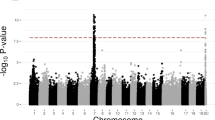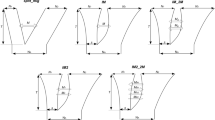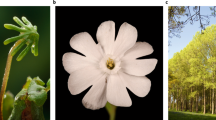Abstract
Sex chromosomes have evolved independently in several different groups of organisms, but they share common features, including genetic degeneration of the Y chromosome1,2. Suppression of recombination between ancestral proto-X and proto-Y chromosomes is thought to have led to their gradual divergence, and to degeneration of the Y chromosome2, but the evolutionary forces responsible are unknown. In non-recombining Y chromosomes, deleterious mutations may be carried to fixation by linked advantageous mutations (“selective sweeps”)3. Occurrence of deleterious mutations may drive “Muller's ratchet” (stochastic loss of chromosomes with the fewest mutations)2,4. Selective elimination of deleterious mutations, causing “background selection”5,6 may accelerate stochastic fixation of mildly detrimental mutations2. All these processes lower effective population sizes, and therefore reduce variability of genes in evolving Y chromosomes. We have studied DNA diversity and divergence in a recently described X- and Y-linked gene pair7 (SLX-1 and SLY-1) of the plant Silene latifolia to obtain evidence about the early stages of Y degeneration. Here we show that DNA polymorphism in SLY-1 is 20-fold lower than in SLX-1, but the pattern of polymorphism does not suggest a selective sweep.
This is a preview of subscription content, access via your institution
Access options
Subscribe to this journal
Receive 51 print issues and online access
$199.00 per year
only $3.90 per issue
Buy this article
- Purchase on Springer Link
- Instant access to full article PDF
Prices may be subject to local taxes which are calculated during checkout


Similar content being viewed by others
References
Bull, J. J. Evolution of Sex Determining Mechanisms. (Benjamin/Cummings, Menlo Park, 1993).
Charlesworth, B. The evolution of chromosomal sex determination and dosage compensation. Curr. Biol. 6, 149–162 (1996).
Rice, W. R. Genetic hitchhiking and the evolution of reduced genetic activity of the Y sex chromosome. Genetics 116, 161–167 (1987).
Manning, J. T. & Thompson, D. J. Muller's ratchet and the accumulation of favourable mutations. Acta Biotheoretica 33, 219–225 (1984).
Charlesworth, D., Charlesworth, B. & Morgan, M. T. The pattern of neutral molecular variation under the background selection model. Genetics 141, 1619–1632 (1995).
Orr, H. A. & Kim, Y. An adaptive hypothesis for the evolution of the Y chromosome. Genetics 150, 1693–1698 (1998).
Delichère, C. et al. SlY1, the first active gene cloned from a plant Y chromosome encodes a WD-repeat protein. EMBO J. 18, 4169–4179 (1999).
Grant, S. et al. Genetics of sex determination in flowering plants. Dev. Genet. 15, 214–230 (1994).
Westergaard, M. The mechanism of sex determination in dioecious flowering plants. Adv. Genet. 9, 217–281 (1959).
Desfeux, C. et al. Evolution of reproductive systems in genus Silene. Proc. R. Soc. Lond. B. 263, 409–414 (1996).
Anagnostopoulos, T., Green, P. M., Rowley, G., Lewis, C. M. & Giannelli, F. DNA variation in a 5-Mb region of the X-chromosome and estimates of sex-specific/type-specific mutation rates. Am. J. Hum. Genet. 64, 508–517 (1999).
Burrows, W. & Ryder, O. A. Y-chromosome variation in great apes. Nature 385, 125–126 (1997).
Lundrigan, B. L. & Tucker, P. K. Tracing paternal ancestry in mice, using the Y-linked sex-determining locus Sry. Mol. Biol. Evol. 11, 483–492 (1994).
Nachman, M. W. & Aquadro, C. F. Polymorphism and divergence at the 5′ flanking region of the sex determining locus, Sry, in mice. Mol. Biol. Evol. 11, 539–547 (1994).
Zurovcova, M. & Eanes, W. F. Lack of nucleotide polymorphism in the Y-linked sperm flagellar dynein gene Dhc-Yh3 of Drosophila melanogaster and D. simulans. Genetics 153, 1709–1715 (1999).
McAllister, B. & Charlesworth, B. Reduced sequence variability on the neo-Y chromosome of Drosophila americana americana. Genetics 153, 221–233 (1999).
Ye, D. et al. Sex determination in the dioecious Melandrium. I. First lessons from androgenic haploids. Sex. Plant Reprod. 3, 179–186 (1990).
Vagera, J., Paulikova, D. & Dolezel, J. The development of male and female regenerants by in vitro Androgenesis in dioecious plant Melandrium album. Ann. Botany 73, 455–459 (1994).
Bùzek, J. et al. Isolation and characterization of X chromosome-derived DNA sequences from a dioecious plant Melandrium album. Chromosome Res. 5, 57–65 (1997).
Guttman, D. S. & Charlesworth, D. An X-linked gene with a degenerate Y-linked homologue in a dioecious plant. Nature 393, 263–265 (1998).
Nei, M. Molecular Evolutionary Genetics. (Columbia Univ. Press, New York, 1987).
Hudson, R. R. & Kaplan, N. L. Statistical properties of the number of recombination events in the history of a sample of DNA sequences. Genetics 111, 147–164 (1985).
Hudson, R. R. Estimating the recombination parameter of a finite population model without selection. Genet. Res. 50, 245–250 (1987).
Gaut, B. S. Molecular clocks and nucleotide substitution rates in higher plants. Evol. Biol. 30, 93–120 (1998).
Hudson, R. R. Gene genealogies and the coalescent process. Oxf. Surv. Evol. Biol. 7, 1–44 (1990).
Fu, Y. -X. & Li, W.-H. Statistical tests of neutrality of mutations. Genetics 133, 693–709 (1993).
Tajima, F. Statistical method for testing the neutral mutation hypothesis by DNA polymorphism. Genetics 123, 585–595 (1989).
Filatov., D. A. & Charlesworth, D. DNA polymorphism, haplotype structure and balancing selection in the Leavenworthia PgiC locus. Genetics 153, 1423–1434 (1999).
Braverman, J. M., Hudson, R. R., Kaplan, N. L., Langley, C. H. & Stephan, W. The hitchhiking effect on the site frequency spectrum of DNA polymorphism. Genetics 140, 783–796 (1995).
Kumar, S., Tamura, K. & Nei, M. MEGA: Molecular Evolutionary Genetics Analysis, version 1.0. (Pennsylvania State Univ., Univ. Park, 1993).
Acknowledgements
We thank M. Turelli and B. Charlesworth for discussions and advice. D.C. was supported by the Natural Environment Research Council of Great Britain, D.A.F. by a grant from the Leverhulme Trust, and F.M. and I.N. by research contracts from the Centre National de la Recherche Scientifique, the Institut National de la Recherche Agrononique and the Ecole Normale Supérieure of France.
Author information
Authors and Affiliations
Corresponding author
Rights and permissions
About this article
Cite this article
Filatov, D., Monéger, F., Negrutiu, I. et al. Low variability in a Y-linked plant gene and its implications for Y-chromosome evolution. Nature 404, 388–390 (2000). https://doi.org/10.1038/35006057
Received:
Accepted:
Issue Date:
DOI: https://doi.org/10.1038/35006057
This article is cited by
-
Evolution of a plant sex chromosome driven by expanding pericentromeric recombination suppression
Scientific Reports (2024)
-
Gene flow signature in the S-allele region of cultivated buckwheat
BMC Plant Biology (2019)
-
The slowdown of Y chromosome expansion in dioecious Silene latifolia due to DNA loss and male-specific silencing of retrotransposons
BMC Genomics (2018)
-
Extremely low nucleotide diversity in the X-linked region of papaya caused by a strong selective sweep
Genome Biology (2016)
-
Neo-sex chromosomes of Ronderosia bergi: insight into the evolution of sex chromosomes in grasshoppers
Chromosoma (2015)
Comments
By submitting a comment you agree to abide by our Terms and Community Guidelines. If you find something abusive or that does not comply with our terms or guidelines please flag it as inappropriate.



